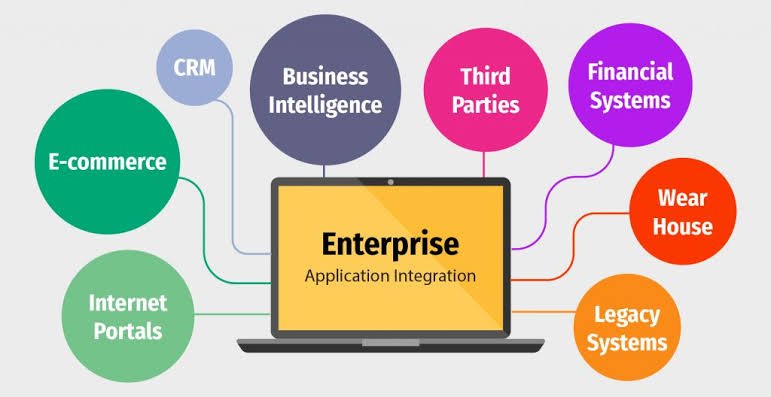Enterprise Application Integration Isn’t As Expensive as You Might Think
What might seem expensive in an instance may not be so a while later, depending on benefits, situation, or need. Insurance costs of a new car, a fire-protected house, and integrating your apps are all such things. Before an accident, before a wildfire, and before a huge loss, all of them seem expensive, don’t they? However, we are not here to convince you on insurance or fireproofing. Enterprise Application Integration is what we will talk about and explain, along with benefits and costs as per goals and ROI.
What is Enterprise Application Integration?
Enterprise App Integration is the process of connecting different business applications, systems, and databases to enable data exchange and workflow automation. Organizations often use multiple software solutions for various functions, such as CRM, ERP, HRM, and accounting. Without integration, systems operate in silos, leading to inefficiencies and data inconsistencies.
EAI ensures that all enterprise applications communicate effectively, eliminating redundant processes and improving operational efficiency. It involves techniques like middleware, APIs, and cloud-based integrations to synchronize data and enable real-time updates across platforms.
By implementing EAI, businesses can streamline operations, enhance decision-making with accurate data, and improve collaboration between departments. It reduces manual data entry, minimizes errors, and allows enterprises to scale effortlessly. Ultimately, it is essential for firms looking to optimize performance, enhance productivity, and gain a competitive edge.
Benefits of Integrating Enterprise Solutions
Modern businesses rely on multiple software applications to manage operations, customer relationships, finance, human resources, and logistics. However, when these systems operate in isolation, inefficiencies arise. Integrating enterprise solutions creates a seamless, data-driven environment that enhances productivity, decision-making, and overall business performance.
- Improved Data Accuracy and Consistency
Enterprise integration ensures real-time data synchronization across all business applications, eliminating manual data entry and reducing errors. When CRM, ERP, and HR systems share the same database, managers make clever decisions based on accurate and up-to-date information.
- Enhanced Operational Efficiency
Integrating enterprise solutions streamlines business processes by automating repetitive tasks and facilitating smooth data flow between departments. It leads to increased efficiency, reduced operational costs, and faster response times. Employees can access relevant information without switching between multiple platforms, improving productivity.
- Better Collaboration and Communication
A unified system allows departments to work collaboratively by providing a centralized source of truth. Sales, marketing, and customer service teams can access the same customer data, leading to improved coordination, better service delivery, and enhanced customer satisfaction.
- Scalability and Flexibility
As businesses grow, their software requirements evolve. An integrated enterprise solution allows companies to scale effortlessly by incorporating new functionalities, users, and data sources without disrupting operations. It also enables organizations to adapt to market changes and emerging technologies with ease.
- Strengthened Security and Compliance
Enterprise integration enhances security by enforcing centralized access controls, authentication mechanisms, and encryption protocols. Organizations can maintain compliance with industry regulations through secure data transfers and protecting sensitive information from breaches.
- Cost Savings and Higher ROI
By eliminating redundant software, reducing manual processes, and improving efficiency, enterprise integration helps businesses save time and resources. The long-term cost benefits outweigh the initial investment, providing a higher return on investment (ROI).
- Competitive Advantage
A well-integrated enterprise ecosystem enables businesses to respond quickly to market demands, launch new products faster, and improve customer experiences. This agility positions them ahead of competitors in an ever-evolving business landscape.
Cost of EAI as per Goals and ROI
Enterprise-wide integration plays a crucial role in streamlining operations, enhancing cohesive work, and improving system reliability. While the initial investment may seem significant, the long-term return on investment (ROI) justifies the cost. The total expenditure depends on business goals, integration complexity, and scalability requirements.
- Cost as per Business Goals
Small-Scale Integrations
Businesses with minimal integration needs, such as API-based connections, can implement cost-effective solutions without extensive infrastructure changes.
Mid-Level Integrations
Companies requiring moderate automation and cross-platform data sharing may need middleware solutions that involve a higher investment but offer improved efficiency.
Enterprise-Level Integrations
Large enterprises integrating legacy systems, cloud platforms, and AI-driven analytics face higher costs due to the need for custom development, security compliance, and scalability.
- Long-Term ROI and Justification
Reduced Operational Costs
By automating workflows and eliminating redundant processes, EAI reduces manual labor, lowering long-term administrative expenses.
Improved Data Accuracy
Seamless integration ensures data consistency across multiple systems, reducing errors and improving decision-making.
Enhanced Productivity
EAI connects various applications, enabling real-time collaboration and faster processing of business operations.
Scalability for Growth
An integrated system allows businesses to scale without system disruptions, supporting expansion and long-term profitability.
Conclusion
While Enterprise Application Integration requires an upfront investment, its ability to improve efficiency, scalability, and revenue generation makes it a smart long-term strategy. Businesses that adopt EAI benefit from reduced costs, enhanced data utilization, and seamless operations, ensuring a significant return on investment. This article covers the meaning and benefits of EAI while justifying its costs as per business goals and return on investment. Consult us if you want to integrate all your enterprise apps for cohesive enterprise automation and timely data sharing.






